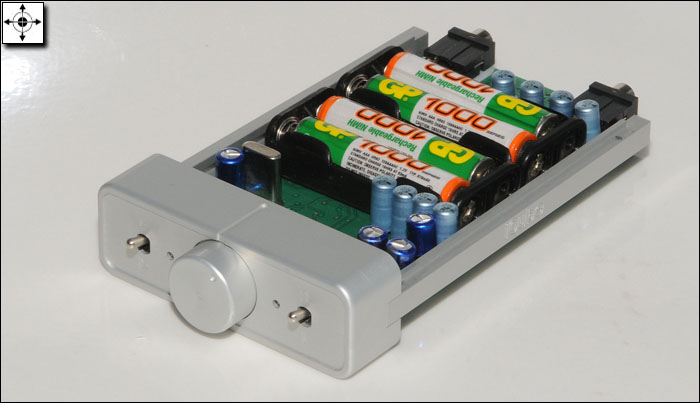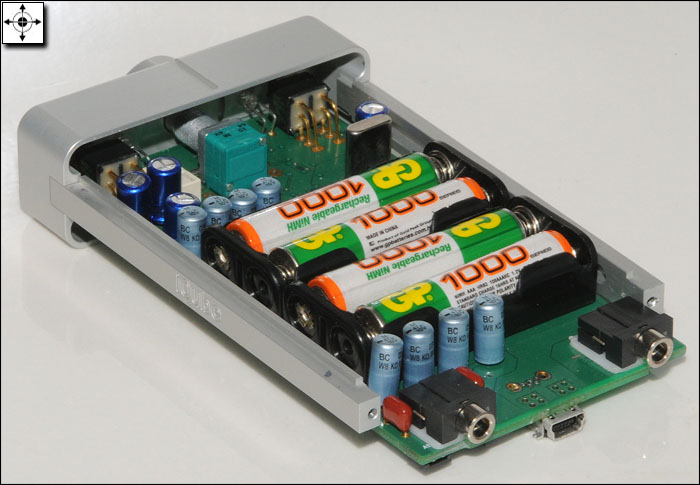This review page is supported in part by the sponsors whose ad banners are displayed below |
 |
 |
When possible, we listened to the iQube with a PC source in either a listen-only or casual-listen mode. The latter did not take advantage of XXHighEnd’s superb feature to kill off audio-redundant processes that require CPU attention, I/O activity and memory space but which are needed to do productive work on the computer. With the services and processes shut down, the computer turns into a fully dedicated music source but no longer allows regular work. We listened with the same headsets that we used for our original iQube V1 review, namely the Ultrasone foldable icons at €119 the pair, a Sony MDR F1 and a Sennheiser HD-600.

In order to properly evaluate the V2, we first used it like the V1, i.e. strictly fed by one of our iPods using the Qables Gold Cab interconnect between the iPod’s line output and the amp’s line input. The first impression was one of recognition. The sonic character of the V2 was exactly the same as that of the smaller sibling. Speed, grip and neutrality all let the musical nuances flow as intended. Depending on headphone requirements, the tiny switch on the front could be in the ‘big’ or ‘small’ position and in either case, the iQube had plenty of power for the most difficult headset with headroom to spare. The combination of a class-D output stage and power supply oversized for the application makes the dynamic capabilities rather awesome. Full orchestral crescendos are handled with so much ease and control, it is hard to accept that all this comes off a tiny battery-fed amp. Recordings of smaller acoustic groups can be another demanding task yet quick violent shots of snare brushes on drums don’t blur into an indistinguishable mash. Rather, they are translucently depicted in time and space.
|
|
|
When connected to the Vista machine running XXHighEnd, things changed and not a little. With a better input than the iPod would offer, now the V2 really strut its stuff with verve. Playing the same WAV files loaded onto the iPod now from a PC added a complete extra layer to the presentation. The performance dimension or gestalt was enhanced to render the music more fluid. Dynamics, speed and grip remained on the same level but were better integrated. Music flowed more evenly due to tiny details being less obscured without getting edgier nor sharper. Comparing an iPod’s line output to a PC running wonderful player software is like comparing apples and oranges yet does reveal the true capabilities of a DAC/amp combo.

The new USB DAC matches very well and does not change the sonic fingerprint of the amp. Its forté of delivering dynamics and speed while being as neutral as can be has not been compromised with the addition of the DAC circuit. What did change were the two criticisms we had of the V1. The attenuator knob is now equipped with a little dent to indicate volume setting. Next, one no longer needs to study and then practice how to open the amp’s casing to replace the batteries. The iQube comes standard with rechargeable batteries.
Charging is child’s play. Just hook the V2 via USB to PC or Mac. While charging, the amp is instantly ready to play. There’s no need for any external power adapters or such. A fully charged V2 lasts longer than there are hours in an overtime work day mainly due to the prudent power consumption of its class-D design.

Our collection includes a Ray Samuels Audio Emmeline Predator and we compared this amp/DAC to the iQube V2. Both handle 16/44.1 inputs but perform their amplification differently. The V2 uses switching, the Predator more conventional op amps. As a result of the comparison, we found the V2 more in charge of dynamic capabilities and less forward in presentation than the Predator. The American design has a more pronounced voicing where the Dutch design is more neutral. With USB input from PC, jitter is noticeable enhanced by the Predator’s voicing to gain a little emphasis in the frequency extremes. On size, the Predator wins hands down.
|
|
|
Another portable amp we had on hand was the NuForce Icon Mobile. This €114 device also combines a DAC/amp in one box so we put it next in line to the Predator for further comparisons. Though not bad at all, when switching between the two others and the Icon Mobile, the latter’s susceptibility to jitter was clearly noticeable. In this ballpark, the iQube V2 sticks out head and shoulders followed by the Predator, with the Icon Mobile a fair also-run. Though equipped with a USB port, the Icon Mobile is better for less critical jogging or other sports activities where its lower weight becomes the true asset.
Despite its current lack of high-resolution file processing, this second coming of the iQube is highly satisfying and takes the Dutch DAC/amp combo out of the iPod-only portable iCute league straight to the top of battery-powered high-end headphone amps. |
|
Quality of packing: Very well packed in a padded tin box.
Reusability of packing: Yes.
Ease of unpacking/repacking: Easy.
Condition of component received: Final pre-production model.
Completeness of delivery: The final product will include cables and straps.
Quality of owner's manual: Was not included.
Website comments: Good and informative.
Human interactions: Professional and courteous.
Pricing: Fair-priced for Europe, pretty steep for US due to exchange rates.
Application conditions: Plug & play.
Final comments & suggestions: When the high-resolution version is ready, an upgrade option of V2 to V3 would be welcome. |
|
 |
|
|
 |
|